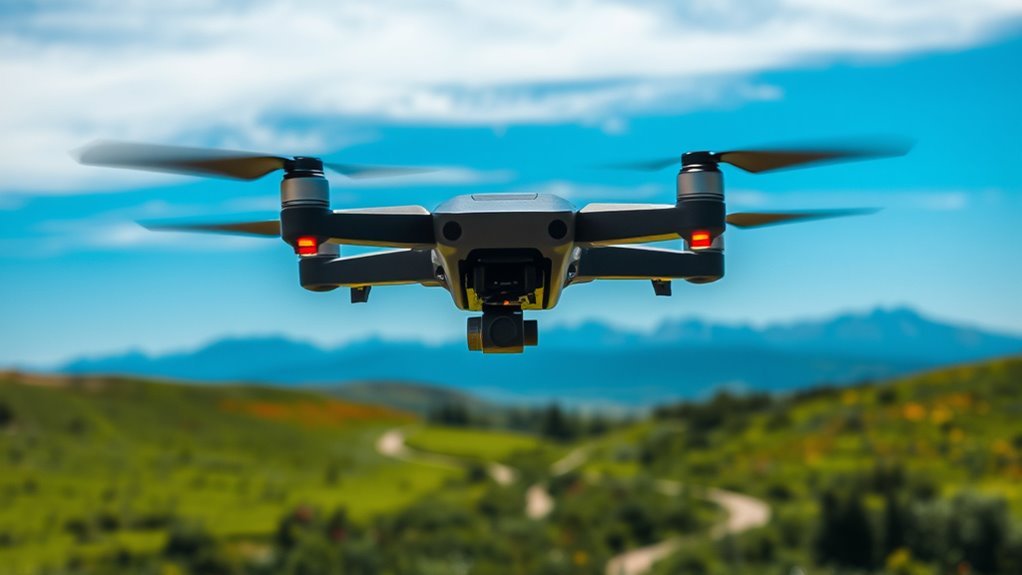Drones are advanced flying devices that use rotors, sensors, and onboard computers to navigate the sky. They’re lightweight, making them easy to transport and operate. You can capture stunning aerial images or videos with high-resolution cameras, including options like 4K and thermal imaging. Their applications span various industries, such as construction, wildlife monitoring, and search and rescue. You’ll discover how they revolutionize tasks and create new opportunities in the world of aerial technology.
Key Takeaways
- Drones operate using rotors, sensors, and onboard computers for stability and effective navigation in the air.
- They offer high-resolution cameras for stunning aerial photography and videography, including options for 4K and thermal imaging.
- Drones are used across various industries, including construction, environmental conservation, and search and rescue, for data collection and monitoring.
- Their lightweight design and intuitive controls make them accessible for both hobbyists and professionals, enhancing creative possibilities.
- Drones revolutionize traditional methods of image capturing and data gathering, offering new perspectives for storytelling and problem-solving.

Drones are revolutionizing the way we capture images, deliver packages, and even monitor wildlife. With advancements in drone technology, you can now take to the skies and experience aerial photography like never before. These unmanned aerial vehicles (UAVs) offer a unique perspective that traditional photography simply can’t match. Whether you’re a hobbyist or a professional, the ability to shoot from above opens up a whole new world of creative possibilities.
When you think about aerial photography, drones are likely the first thing that comes to mind. Their lightweight design and high-resolution cameras allow for stunning shots that can showcase landscapes, events, or even real estate from an angle that catches the eye. Imagine soaring above a sweeping coastline or capturing the intricate layout of a bustling city. With just a few clicks, you can create breathtaking images that tell a story. The ease of use that drones provide means you don’t need to be a tech wizard to get started; their intuitive controls make flying accessible to everyone.
As you dive deeper into this technology, you’ll notice that drones can be equipped with various types of cameras, including 4K video capabilities and thermal imaging options. This versatility means you can tailor your drone to suit your specific needs, whether you’re capturing a sunset, surveying agricultural land, or conducting search and rescue missions. The potential applications are vast, and each flight offers an opportunity to innovate and explore.
You might be wondering how drones actually fly. At the core of their operation is a combination of rotors, sensors, and onboard computers that work together to maintain stability and navigate through the air. These components allow you to control the drone effectively, whether you’re hovering in place or maneuvering through tight spaces. The technology has come a long way, making drones easier to fly than ever before.
In addition to photography, drones are becoming increasingly important in various industries. From construction to environmental conservation, their ability to gather data from above has proven invaluable. Imagine using a drone to monitor wildlife populations or assess the health of crops in real time. This technology is changing the way we approach problems, making it easier to gather information quickly and efficiently.
Frequently Asked Questions
Can Drones Be Used for Personal Photography?
Yes, drones can definitely be used for personal photography! You’ll find that drone photography offers stunning aerial shots and unique perspectives. However, it’s important to be mindful of privacy concerns. Always respect others’ privacy and check local regulations before flying. By doing so, you can capture breathtaking images while staying responsible. So, grab your drone, and start exploring your surroundings from a whole new angle!
Are There Age Restrictions for Flying Drones?
Yes, there are age restrictions for flying drones. In the U.S., you must be at least 16 years old to obtain a Remote Pilot Certificate. Remarkably, about 40% of drone pilots are under 34 years old! Besides age, you’ll also need to meet licensing requirements, which include passing an FAA exam. So, if you’re looking to fly, make sure you meet these criteria to enjoy your drone experience safely and legally.
What Is the Legal Altitude Limit for Drones?
The legal altitude limit for drones is generally 400 feet above ground level, according to FAA regulations. This altitude restriction helps make certain safety in the airspace, preventing conflicts with manned aircraft. If you’re flying near tall structures, you can fly higher but only up to the height of that structure, plus another 400 feet. Always check local laws, as there may be additional altitude restrictions in certain areas or classes of airspace.
How Do I Choose a Drone for Beginners?
When you’re choosing a drone for beginners, consider that nearly 60% of new pilots give up due to complex models. Look for beginner drone features like user-friendly controls, stable flight, and a good battery life. Also, think about drone maintenance—models with durable builds and easy-to-replace parts will save you headaches down the line. Start with something simple and reliable, and you’ll enjoy learning without feeling overwhelmed.
Can Drones Fly in Bad Weather Conditions?
Drones can struggle in bad weather conditions, facing significant weather challenges that affect their stability. High winds, rain, and snow can make it difficult for you to control your drone, potentially leading to crashes. While some drones are designed for adverse weather, many aren’t built for such conditions. Always check the weather forecast before flying, and avoid taking risks that could damage your drone or compromise your safety.
Conclusion
In conclusion, drones have truly taken flight in various fields, from photography to agriculture. Understanding how they soar and the roles they play can help you see the bigger picture. As technology continues to advance, these flying marvels are changing the game and opening up new possibilities. So, whether you’re looking to capture stunning aerial shots or streamline your business, embracing drone technology might just be the ticket to ride into the future.










